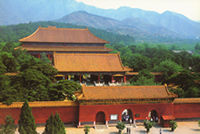
The Ming Dynasty from 1368 to 1644 had 16 emperors. Thirteen of them were buried in Beijing. So their tombs are called Ming Tombs. Through the 5,000 years of Chinese history many emperors left after them large or small tombs, but the Ming Tombs are well preserved today.
A Chinese imperial mausoleum usually consists of two parts, the divine road and the burial palace. The marble archway or paifang is the beginning of the divine road and of the whole Ming Tombs. This carved archway is the largest existent one in China. It bears patterns of clouds and dragons, which is a characteristic of imperial architecture.
The divine road is a passage in front of the tombs to facilitate the sacrificial ceremonies. The two hexagon stone pillars are the sign of a divine road.
Behind the pillars are 24 stone animals. They are four horses, four legendary animals called qilin, four elephants, four camels, four legendary animals called xiezhi, and four lions. Behind the stone animals are 12 stone figures. Each of these life-like statues is carved out of a whole rock.
To arrange stone figures and animals along the divine road is an institution started from Eastern Han Dynasty. The figures serve as guardians and waiters, and the animals are employed to rid evil spirits and symbolise peace.
In the Ming Tombs you often see housed and unhoused stone tablets. To set a stone tablet in front of the tomb is a tradition dating back to the Tang Dynasty. This housed tablet is the only Ming-dynasty structure in the Ming Tombs. On the tablets are carved the edicts and poems of three Qing-dynasty emperors.
The most imposing building in the Ming Tombs is the Chamber of Divine Favour in Changling Mausoleum where Emperor Zhu Di is buried. The Chamber was originally called Sacrificial Chamber. It was a place to worship the memorial tablets of emperors and empresses and to hold sacrificial ceremonies. Later it was renamed to indicate that in this place one would express gratitude to deceased ancestors and receive blessing from them.
 Tours to Ming Tombs Tours to Ming Tombs
|